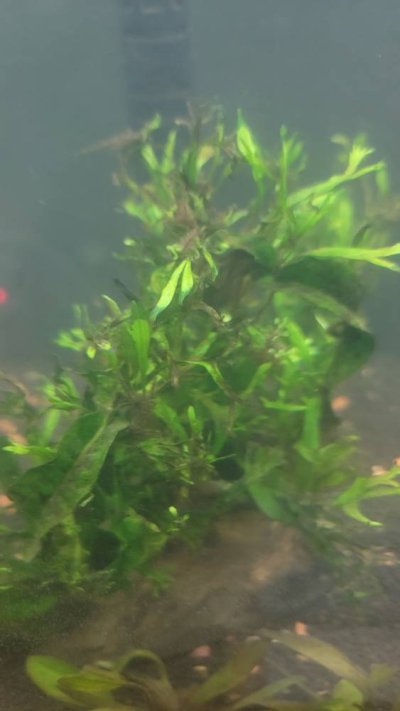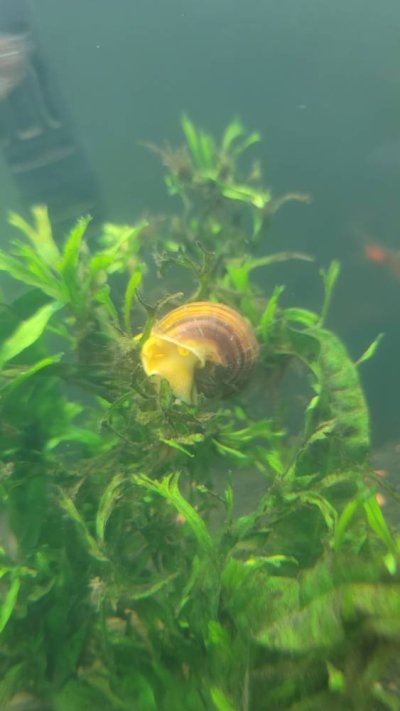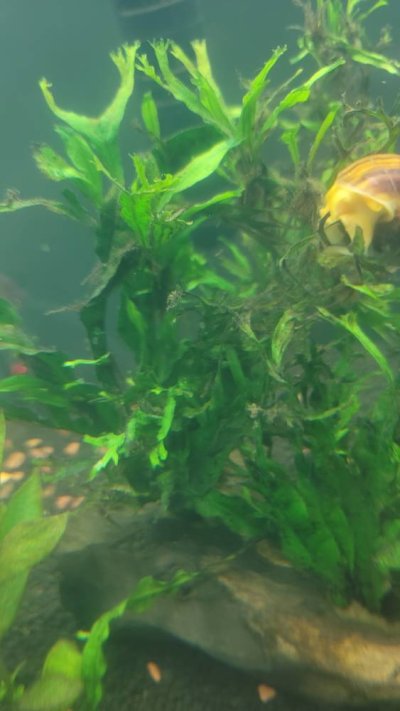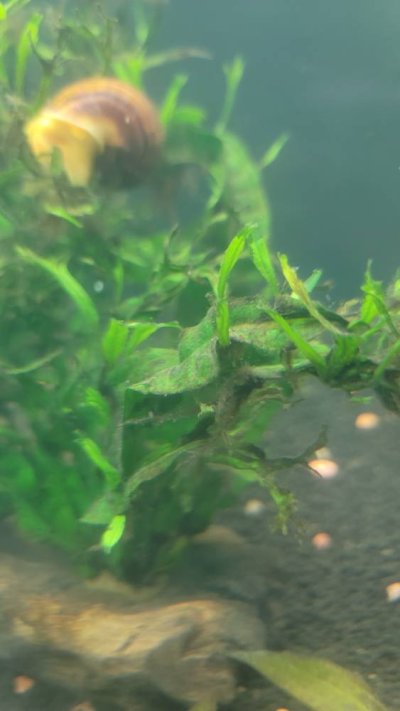You are using an out of date browser. It may not display this or other websites correctly.
You should upgrade or use an alternative browser.
You should upgrade or use an alternative browser.
Brown hair on my plant?
- Thread starter Fishlover94
- Start date
The friendliest place on the web for anyone with an interest in aquariums or fish keeping!
If you have answers, please help by responding to the unanswered posts.
If you have answers, please help by responding to the unanswered posts.
Photo isnt too clear. What type of plant is it? Some variety of java fern?
It looks like the roots that java fern plantlets grow, which is how java fern reproduce. Are there little plants growing on the leafs of your plants? If so these will eventually grow enough to detach from the parent plant and float away to attach somewhere else in your aquascape. If you dont want them just pick them off the plant and throw them away.
It looks like the roots that java fern plantlets grow, which is how java fern reproduce. Are there little plants growing on the leafs of your plants? If so these will eventually grow enough to detach from the parent plant and float away to attach somewhere else in your aquascape. If you dont want them just pick them off the plant and throw them away.
Fishlover94
Aquarium Advice Activist
Caliban07
Aquarium Advice Addict
It looks like black beard algae. It’s taking advantage of leaves that are not healthy.
It’s not really known 100% what causes it in aquariums and you don’t really see it in nature. In fact there are two 20+ page threads on a planted tank forum I frequent where many experienced aquascapers and scientists discuss it in detail but never really came to a consensus. Only hypotheses ranging from too much light, imbalance of nutrients, lack of flow, lack of oxygen, vitamin B12, high organic loading and so on. It’s hard to pinpoint because it’s so common and exists in nearly all of these cases. The other thing is that once it’s there it is very difficult to kill without using chemicals and you really don’t want to go down that route.
Personally, my hypothesis is that many of these scenarios above are interlinked and I see a trend in threads that have this algae ir any algae for that matter. In most tank journals it’s almost inevitable that this algae or any algae shows up in the early stages of a tank’s progression. The hobbyists tries an absolute multitude of things to try and fix it ranging from dosing more nutrients to help plants, cutting back on nutrients, doing more water changes, reducing light, decreasing photoperiod, increasing flow, cleaning the filter more etc. What I notice is that in nearly all of these threads the exact same thing happens that I notice in my tanks. They battle this nuisance for weeks, months, then one day it just stops. The proud hobbyist goes on to say what they did to keep it at bay and what they think was the cause but the truth is, they did so many things it was almost impossible to pinpoint. What I believe from the predictable trend I see in almost all of these threads is that the hobbyist starts winning the battle after 4,6,8 months. The algae stops growing and this is what I believe is down to biofilter maturity.
New aquariums or aquariums that undergo vigorous cleaning or cycle disruptions will inevitably grow algae. Cyanobacteria, diatoms, Black beard algae, staghorn algae, green spot algae you name it. The tank just does not have the microbes required to decompose organic material yet or they are not in abundance enough to decompose with any degree of efficiency and so this gives way to algae to take a hold.
You see, oxygen is the prime metric for decomposition. This is what field scientists measure to check how polluted waterways are. They measure the oxygen demand in the system. If the oxygen is low or the oxygen demand is high it indicates high organic loading and these waterways are often polluted. So first we must ensure that oxygen is constantly high. We can do this by increasing surface turbulence and flow. We can supply oxygen to enable microbes to decompose.
Plants are fantastic suppliers of oxygen when they are healthy. But when they are not, which is often the case when first establishing themselves, they actually contribute to oxygen demand. Plants when healthy and supplying oxygen to their root system, enable microorganisms to grow in the substrate which assist them in obtaining nutrients. When there is too much dissolved organics in the water they cannot efficiently take in carbon dioxide and nutrients through their leaves because the dissolved organics coat the leaves and grow algae and other organisms on the leaf boundary further obstructing uptake. It’s a vicious cycle. When the biofilter is fully established things start to go in a positive direction and algae recedes. This takes patience and good oxygen levels. Oxygen is king.
So how can we reduce the biological oxygen demand?
Changing water to remove dissolved organics, aerate the aquarium, improve flow, grow healthy plants, use floating plants, feed less, stock less, use shrimp and snails to feed on excess food and graze algae. It’s ironic because algae supply oxygen too. It is my belief that algae grows to support life in a compromised system however, if we minimise the oxygen demand then remain patient algae will always pass and higher plants will take over.
Many people who say they have a mature biofilter often don’t. If a tank has been set up for a long time it doesn’t mean anything if the filter, plant/microbe system in it’s entirety is constantly disturbed and often times people do this weekly or they compromise oxygen levels almost daily with poor practices which means their biological filter can never truly establish.
I know this long winded explanation is probably not what you want to hear but I promise you algae will pass in time if you use these tips to maximise oxygen levels. The pattern is so clear to me but nobody seems to notice.
It’s not really known 100% what causes it in aquariums and you don’t really see it in nature. In fact there are two 20+ page threads on a planted tank forum I frequent where many experienced aquascapers and scientists discuss it in detail but never really came to a consensus. Only hypotheses ranging from too much light, imbalance of nutrients, lack of flow, lack of oxygen, vitamin B12, high organic loading and so on. It’s hard to pinpoint because it’s so common and exists in nearly all of these cases. The other thing is that once it’s there it is very difficult to kill without using chemicals and you really don’t want to go down that route.
Personally, my hypothesis is that many of these scenarios above are interlinked and I see a trend in threads that have this algae ir any algae for that matter. In most tank journals it’s almost inevitable that this algae or any algae shows up in the early stages of a tank’s progression. The hobbyists tries an absolute multitude of things to try and fix it ranging from dosing more nutrients to help plants, cutting back on nutrients, doing more water changes, reducing light, decreasing photoperiod, increasing flow, cleaning the filter more etc. What I notice is that in nearly all of these threads the exact same thing happens that I notice in my tanks. They battle this nuisance for weeks, months, then one day it just stops. The proud hobbyist goes on to say what they did to keep it at bay and what they think was the cause but the truth is, they did so many things it was almost impossible to pinpoint. What I believe from the predictable trend I see in almost all of these threads is that the hobbyist starts winning the battle after 4,6,8 months. The algae stops growing and this is what I believe is down to biofilter maturity.
New aquariums or aquariums that undergo vigorous cleaning or cycle disruptions will inevitably grow algae. Cyanobacteria, diatoms, Black beard algae, staghorn algae, green spot algae you name it. The tank just does not have the microbes required to decompose organic material yet or they are not in abundance enough to decompose with any degree of efficiency and so this gives way to algae to take a hold.
You see, oxygen is the prime metric for decomposition. This is what field scientists measure to check how polluted waterways are. They measure the oxygen demand in the system. If the oxygen is low or the oxygen demand is high it indicates high organic loading and these waterways are often polluted. So first we must ensure that oxygen is constantly high. We can do this by increasing surface turbulence and flow. We can supply oxygen to enable microbes to decompose.
Plants are fantastic suppliers of oxygen when they are healthy. But when they are not, which is often the case when first establishing themselves, they actually contribute to oxygen demand. Plants when healthy and supplying oxygen to their root system, enable microorganisms to grow in the substrate which assist them in obtaining nutrients. When there is too much dissolved organics in the water they cannot efficiently take in carbon dioxide and nutrients through their leaves because the dissolved organics coat the leaves and grow algae and other organisms on the leaf boundary further obstructing uptake. It’s a vicious cycle. When the biofilter is fully established things start to go in a positive direction and algae recedes. This takes patience and good oxygen levels. Oxygen is king.
So how can we reduce the biological oxygen demand?
Changing water to remove dissolved organics, aerate the aquarium, improve flow, grow healthy plants, use floating plants, feed less, stock less, use shrimp and snails to feed on excess food and graze algae. It’s ironic because algae supply oxygen too. It is my belief that algae grows to support life in a compromised system however, if we minimise the oxygen demand then remain patient algae will always pass and higher plants will take over.
Many people who say they have a mature biofilter often don’t. If a tank has been set up for a long time it doesn’t mean anything if the filter, plant/microbe system in it’s entirety is constantly disturbed and often times people do this weekly or they compromise oxygen levels almost daily with poor practices which means their biological filter can never truly establish.
I know this long winded explanation is probably not what you want to hear but I promise you algae will pass in time if you use these tips to maximise oxygen levels. The pattern is so clear to me but nobody seems to notice.
Similar threads
- Replies
- 3
- Views
- 556
- Replies
- 13
- Views
- 914
- Replies
- 6
- Views
- 945
- Replies
- 3
- Views
- 557
- Replies
- 1
- Views
- 426




